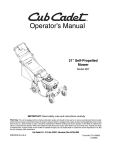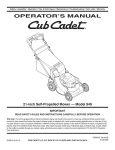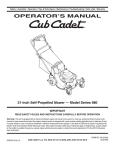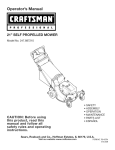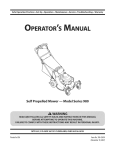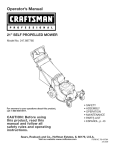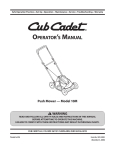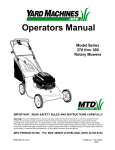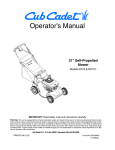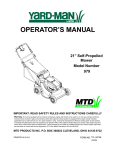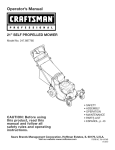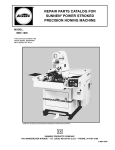Download Cub Cadet 640 Operator`s manual
Transcript
Safe Operation Practices • Set-Up • Operation • Maintenance • Service • Troubleshooting • Warranty Operator’s Manual Self Propelled Mower — Model Series 990 WARNING READ AND FOLLOW ALL SAFETY RULES AND INSTRUCTIONS IN THIS MANUAL BEFORE ATTEMPTING TO OPERATE THIS MACHINE. FAILURE TO COMPLY WITH THESE INSTRUCTIONS MAY RESULT IN PERSONAL INJURY. CUB CADET LLC, P.O. BOX 361131 CLEVELAND, OHIO 44136-0019 Printed In USA Form No. 769-04710 (December 15, 2008) 1 To The Owner Thank You Thank you for purchasing a Lawn Mower manufactured by Cub Cadet LLC. It was carefully engineered to provide excellent performance when properly operated and maintained. Please read this entire manual prior to operating the equipment. It instructs you how to safely and easily set up, operate and maintain your machine. Please be sure that you, and any other persons who will operate the machine, carefully follow the recommended safety practices at all times. Failure to do so could result in personal injury or property damage. All information in this manual is relative to the most recent product information available at the time of printing. Review this manual frequently to familiarize yourself with the machine, its features and operation. Please be aware that this Operator’s Manual may cover a range of product specifications for various models. Characteristics and features discussed and/or illustrated in this manual may not be applicable to all models. Cub Cadet LLC reserves the right to change product specifications, designs and equipment without notice and without incurring obligation. If you have any problems or questions concerning the machine, phone your local Cub Cadet dealer or contact us directly. Cub Cadet’s Customer Support telephone numbers, website address and mailing address can be found on this page. We want to ensure your complete satisfaction at all times. Throughout this manual, all references to right and left side of the machine are observed from the operating position. The engine manufacturer is responsible for all engine-related issues with regards to performance, power-rating, specifications, warranty and service. Please refer to the engine manufacturer’s Owner’s/Operator’s Manual, packed separately with your machine, for more information. Table of Contents Safe Operation Practices......................................... 3 Assembly & Set-Up................................................... 9 Controls & Features.................................................12 Operation.................................................................13 Maintenance & Adjustment..................................14 Service......................................................................16 Troubleshooting......................................................19 Illustrated Parts List............................................... 22 Warranty................................................................. 28 Record Product Information Model Number Before setting up and operating your new equipment, please locate the model plate on the equipment and record the information in the provided area to the right. You can locate the model plate by standing at the operator’s position and looking down at the rear of the deck. This information will be necessary, should you seek technical support via our web site or with your local Cub Cadet dealer. Serial Number Customer Support If you have difficulty assembling this product or have any questions regarding the controls, operation, or maintenance of this machine, you can seek help from the experts. Choose from the options below: 2 ◊ Visit us on the web at www.cubcadet.com ◊ Locate your nearest Cub Cadet Dealer at (877) 282-8684 ◊ Write us at Cub Cadet LLC • P.O. Box 361131 • Cleveland, OH • 44136-0019 Important Safe Operation Practices 2 WARNING: This symbol points out important safety instructions which, if not followed, could endanger the personal safety and/or property of yourself and others. Read and follow all instructions in this manual before attempting to operate this machine. Failure to comply with these instructions may result in personal injury. When you see this symbol. HEED ITS WARNING! California Proposition 65 WARNING: Engine Exhaust, some of its constituents, and certain vehicle components contain or emit chemicals known to State of California to cause cancer and birth defects or other reproductive harm. WARNING: Battery posts, terminals, and related accessories contain lead and lead compounds, chemicals known to the State of California to cause cancer and reproductive harm. Wash hands after handling. DANGER: This machine was built to be operated according to the safe operation practices in this manual. As with any type of power equipment, carelessness or error on the part of the operator can result in serious injury. This machine is capable of amputating fingers, hands, toes and feet and throwing objects. Failure to observe the following safety instructions could result in serious injury or death. General Operation 1. Read this operator’s manual carefully in its entirety before attempting to assemble this machine. Read, understand, and follow all instructions on the machine and in the manuals) before operation. Keep this manual in a safe place for future and regular reference and for ordering replacement parts 6. Thoroughly inspect the area where the equipment is to be used. Remove all stones, sticks, wire, bones, toys and other foreign objects, which could be tripped over or picked up and thrown by the blade. Thrown objects can cause serious personal injury. 7. Plan your mowing pattern to avoid discharge of material toward roads, sidewalks, bystanders and the like. Also, avoid discharging material against a wall or obstruction, which may cause discharged material to ricochet back toward the operator. 2. Be completely familiar with the controls and the proper use of this machine before operating it. 3. This machine is a precision piece of power equipment, not a plaything. Therefore, exercise extreme caution at all times. This machine has been designed to perform one job: to mow grass. Do not use it for any other purpose. 8. To help avoid blade contact or a thrown object injury, stay in operator zone behind handles and keep children, bystanders, helpers and pets at least 75 feet from mower while it is in operation. Stop machine if anyone enters area. 4. Never allow children under 14 years of age to operate this machine. Children 14 and over should read and understand the instructions and safe operation practices in this manual and on the machine and should be trained and supervised by an adult. 9. Always wear safety glasses or safety goggles during operation and while performing an adjustment or repair to protect your eyes. Thrown objects which ricochet can cause serious injury to the eyes. 5. Only responsible individuals who are familiar with these rules of safe operation should be allowed to use this machine. 10. Wear sturdy, rough-soled work shoes and close-fitting slacks and shirts. Shirts and pants that cover the arms and legs and steel-toed shoes are recommended. Never operate this machine in bare feet, sandals, slippery or lightweight (e.g. canvas) shoes. 11. Do not put hands or feet near rotating parts or under the cutting deck. Contact with blade can amputate fingers, hands, toes and feet. 3 12. A missing or damaged discharge cover can cause blade contact or thrown object injuries. 13. Many injuries occur as a result of the mower being pulled over the foot during a fall caused by slipping or tripping. Do not hold on to the mower if you are falling; release the handle immediately. 14. Never pull the mower back toward you while you are walking. If you must back the mower away from a wall or obstruction first look down and behind to avoid tripping and then follow these steps: a. Step back from mower to fully extend your arms. b. Be sure you are well balanced with sure footing. c. Pull the mower back slowly, no more than half way toward you. d. Repeat these steps as needed. 15. Do not operate the mower while under the influence of alcohol or drugs. 16. Do not engage the self-propelled mechanism on machines so equipped while starting engine. 17. The blade control handle is a safety device. Never attempt to bypass its operation. Doing so makes the safety device inoperative and may result in personal injury through contact with the rotating blade. The blade control handle must operate easily in both directions and automatically return to the disengaged position when released. 18. 19. Never operate the mower in wet grass. Always be sure of your footing. A slip and fall can cause serious personal injury. If you feel you are losing your footing, release the blade control handle immediately and the blade will stop rotating within three seconds. Mow only in daylight or good artificial light. Walk, never run. 20. Stop the blade when crossing gravel drives, walks or roads. 21. If the equipment should start to vibrate abnormally, stop the engine and check immediately for the cause. Vibration is generally a warning of trouble. 22. Shut the engine off and wait until the blade comes to a complete stop before removing the grass catcher or unclogging the chute. The cutting blade continues to rotate for a few seconds after the blade control is released. Never place any part of the body in the blade area until you are sure the blade has stopped rotating. When starting engine, pull cord slowly until resistance is felt, then pull rapidly. Rapid retraction of starter cord (kickback) will pull hand and arm toward engine faster than you can let go. Broken bones, fractures, bruises or sprains could result. 28. If situations occur which are not covered in this manual, use care and good judgement. Contact Customer Support for assistance or the name of the nearest service dealer. Slope Operation Slopes are a major factor related to slip and fall accidents, which can result in severe injury. Operation on slopes requires extra caution. If you feel uneasy on a slope, do not mow it. For your safety, use the slope gauge included as part of this manual to measure slopes before operating this machine on a sloped or hilly area. If the slope is greater than 15 degrees, do not mow it. Do: 1. Mow across the face of slopes; never up and down. Exercise extreme caution when changing direction on slopes. 2. Watch for holes, ruts, rocks, hidden objects, or bumps which can cause you to slip or trip. Tall grass can hide obstacles. 3. Always be sure of your footing. A slip and fall can cause serious personal injury. If you feel you are losing your balance, release the blade control handle immediately and the blade will stop rotating within three (3) seconds. Do Not: 1. Do not mow near drop-offs, ditches or embankments, you could lose your footing or balance. 2. Do not mow slopes greater than 15 degrees as shown on the slope gauge. 3. Do not mow on wet grass. Unstable footing could cause slipping. Children Tragic accidents can occur if the operator is not alert to the presence of children. Children are often attracted to the mower and the mowing activity. They do not understand the dangers. Never assume that children will remain where you last saw them. 1. Keep children out of the mowing area and under watchful care of a responsible adult other than the operator. 2. Be alert and turn mower off if a child enters the area. Never operate mower without proper trail shield, discharge cover, grass catcher, blade control handle or other safety protective devices in place and working. Never operate mower with damaged safety devices. Failure to do so can result in personal injury. 3. Before and while moving backwards, look behind and down for small children. 4. Use extreme care when approaching blind corners, doorways, shrubs, trees, or other objects that may obscure your vision of a child who may run into the mower. 24. Muffler and engine become hot and can cause a burn. Do not touch. 5. Keep children away from hot or running engines. They can suffer burns from a hot muffler. 25. Never attempt to make a wheel or cutting height adjustment while the engine is running. 6. 26. Only use parts and accessories made for this machine by the manufacturer. Failure to do so can result in personal injury. Never allow children under 14 years of age to operate this machine. Children 14 and over should read and understand the instructions and safe operation practices in this manual and on the machine and be trained and supervised by an adult. 23. 4 27. Section 2 — Important Safe Operation Practices Service 3. Check the blade and engine mounting bolts at frequent intervals for proper tightness. Also, visually inspect blade for damage (e.g., bent, cracked, worn) Replace blade with the original equipment manufacture’s (O.E.M.) blade only, listed in this manual. “Use of parts which do not meet the original equipment specifications may lead to improper performance and compromise safety!” 4. Mower blades are sharp and can cut. Wrap the blade or wear gloves, and use extra caution when servicing them. Safe Handling Of Gasoline: 1. To avoid personal injury or property damage use extreme care in handling gasoline. Gasoline is extremely flammable and the vapors are explosive. Serious personal injury can occur when gasoline is spilled on yourself or your clothes, which can ignite. Wash your skin and change clothes immediately. 2. Use only an approved gasoline container. 5. 3. Never fill containers inside a vehicle or on a truck or trailer bed with a plastic liner. Always place containers on the ground away from your vehicle before filling. Keep all nuts, bolts, and screws tight to be sure the equipment is in safe working condition. 6. Never tamper with safety devices. Check their proper operation regularly. 4. Remove gas-powered equipment from the truck or trailer and refuel it on the ground. If this is not possible, then refuel such equipment on a trailer with a portable container, rather than from a gasoline dispenser nozzle. 7. After striking a foreign object, stop the engine, disconnect the spark plug wire and ground against the engine. Thoroughly inspect the mower for any damage. Repair the damage before starting and operating the mower. 5. Keep the nozzle in contact with the rim of the fuel tank or container opening at all times until fueling is complete. Do not use a nozzle lock-open device. 8. Never attempt to make a wheel or cutting height adjustment while the engine is running. 9. 6. Extinguish all cigarettes, cigars, pipes and other sources of ignition. 7. Never fuel machine indoors because flammable vapors will accumulate in the area. 8. Never remove gas cap or add fuel while engine is hot or running. Allow engine to cool at least two minutes before refueling. Grass catcher components, discharge cover, and trail shield are subject to wear and damage which could expose moving parts or allow objects to be thrown. For safety protection, frequently check components and replace immediately with original equipment manufacturer’s (O.E.M.) parts only, listed in this manual. “Use of parts which do not meet the original equipment specifications may lead to improper performance and compromise safety!” 9. Never over fill fuel tank. Fill tank to no more than 1 inch below bottom of filler neck to provide for fuel expansion. 10. 10. Replace gasoline cap and tighten securely. Do not change the engine’s governor setting or over-speed the engine. The governor controls the maximum safe operating speed of the engine. 11. If gasoline is spilled, wipe it off the engine and equipment. Move machine to another area. Wait 5 minutes before starting engine. 11. Check fuel line, tank, cap, and fittings frequently for cracks or leaks. Replace if necessary. 12. Do not crank engine with spark plug removed. 12. Never store the machine or fuel container near an open flame, spark or pilot light as on a water heater, space heater, furnace, clothes dryer or other gas appliances. 13. Maintain or replace safety and instruction labels, as necessary. 13. To reduce fire hazard, keep machine free of grass, leaves, or other debris build-up. Clean up oil or fuel spillage and remove any fuel soaked debris. 14. Observe proper disposal laws and regulations. Improper disposal of fluids and materials can harm the environment. 15. According to the Consumer Products Safety Commission (CPSC) and the U.S. Environmental Protection Agency (EPA), this product has an Average Useful Life of seven (7) years, or 140 hours of operation. At the end of the Average Useful Life have the machine inspected annually by an authorized service dealer to ensure that all mechanical and safety systems are working properly and not worn excessively. Failure to do so can result in accidents, injuries or death. 14. Allow machine to cool at least 5 minutes before storing. General Service: 1. Never run an engine indoors or in a poorly ventilated area. Engine exhaust contains carbon monoxide, an odorless and deadly gas. 2. Before cleaning, repairing, or inspecting, make certain the blade and all moving parts have stopped. Disconnect the spark plug wire and ground against the engine to prevent unintended starting. Do not modify engine To avoid serious injury or death, do not modify engine in any way. Tampering with the governor setting can lead to a runaway engine and cause it to operate at unsafe speeds. Never tamper with factory setting of engine governor. Section 2 — Important Safe Operation Practices 5 Notice Regarding Emissions Engines which are certified to comply with California and federal EPA emission regulations for SORE (Small Off Road Equipment) are certified to operate on regular unleaded gasoline, and may include the following emission control systems: Engine Modification (EM), Oxidizing Catalyst (OC), Secondary Air Injection (SAI) and Three Way Catalyst (TWC) if so equipped. Spark Arrestor Warning: This machine is equipped with an internal combustion engine and should not be used on or near any unimproved forest-covered, brush covered or grass-covered land unless the engine’s exhaust system is equipped with a spark arrester meeting applicable local or state laws (if any). If a spark arrester is used, it should be maintained in effective working order by the operator. In the State of California the above is required by law (Section 4442 of the California Public Resources Code). Other states may have similar laws. Federal laws apply on federal lands. A spark arrester for the muffler is available through your nearest engine authorized service dealer or contact the service department, P.O. Box 361131 Cleveland, Ohio 44136-0019. 6 Section 2 — Important Safe Operation Practices Safety Symbols This page depicts and describes safety symbols that may appear on this product. Read, understand, and follow all instructions on the machine before attempting to assemble and operate. Symbol Description READ THE OPERATOR’S MANUAL(S) Read, understand, and follow all instructions in the manual(s) before attempting to assemble and operate DANGER — ROTATING BLADES To reduce the risk of injury, keep hands and feet away. Do not operate unless discharge cover or grass catcher is in its proper place. If damaged, replace immediately. DANGER — BYSTANDERS Do not mow when children or others are around. DANGER — HAND/ FOOT CUT Keep hands and feet away from rotating parts. DANGER — THROWN DEBRIS Remove objects that can be thrown by the blade in any direction. Wear safety glasses. DANGER — SLOPES Use extra caution on slopes. Do not mow slopes greater than 15°. WARNING—GASOLINE IS FLAMMABLE Allow the engine to cool at least two minutes before refueling. WARNING— CARBON MONOXIDE Never run an engine indoors or in a poorly ventilated area. Engine exhaust contains carbon monoxide, an odorless and deadly gas. WARNING— HOT SURFACE Engine parts, especially the muffler, become extremely hot during operation. Allow engine and muffler to cool before touching. warning: Your Responsibility—Restrict the use of this power machine to persons who read, understand and follow the warnings and instructions in this manual and on the machine. SAVE THESE INSTRUCTIONS! Section 2 — Important Safe Operation Practices 7 8 Section 2 — Important Safe Operation Practices d line (repr esent s a 15 ° slop e) WARNING: Do not operate your lawn mower on such slopes. Do not mow on inclines with a slope in excess of 15 degrees (a rise of approximately 2-1/2 feet every 10 feet). A riding mower could overturn and cause serious injury. Operate riding mowers up and down slopes, never across the face of slopes. Operate walk-behind mowers across the face of slopes, never up and down slopes. Use this page as a guide to determine slopes where you may not operate safely. 15° dotte or a fence post or a corner of a building... long Fold a Sight and hold this level with a vertical tree... 3 Assembly & Set-Up Contents of Carton • One Lawn Mower • One Grass Catcher • One Grass Catcher Adapter • One Side Discharge Chute • One Engine Operator’s Manual • One Bottle of Oil • One Lawn Mower Operator’s Manual Assembly 2. NOTE: This unit is shipped without gasoline or oil in the engine. Fill up gasoline and oil as instructed in the accompanying engine manual BEFORE operating your mower. Locate the hairpin clip on the weld pin on each side of lower handle. a. Handle 1. Remove hairpin clip from this hole. Using a pair of pliers, insert hairpin clip into the hole on pin closest to the bracket. See Fig. 3-2. Repeat on other side. Remove any packing material which may be between upper and lower handles. a. Pull up and back on upper handle as shown in Fig. 3-1. Make certain the lower handle is seated securely into the handle mounting brackets. Do not crimp cables while lifting the handle up. B A A Figure 3-2 b. B NOTE: Make certain the drive cable is routed around the outside and above the lower handle so it does not interfere with attaching the grass bag. The chute door has been designed to move the starter rope out of the way of the bag when the chute door is opened. Figure 3-1 b. Tighten star knobs to secure upper handle to lower handle. Make sure that each carriage bolt is seated properly in the handle. Insert a carriage bolt from the manual bag into the upper hole on the handle mounting bracket. Secure with one plastic wing nut, also included in the manual bag. Repeat on other side with remaining hardware. 3. The rope guide, which is connected to the support rod, is located on the right side of the lower handle. See Fig. 3-3. 9 A 2. Replace with grass bag adapter, while making sure the front lip of adapter goes under the edge of the deck. Secure with wing nuts previously removed. 3. Lift chute door on the grass bag adapter and slide grass bag onto the adapter. See Fig. 3-5. B C 3 Figure 3-3 4. a. Hold blade control against upper handle. b. Pull starter rope out of the engine. Release blade control. c. Slip starter rope into rope guide. Attach cables to the lower handle with the cable ties already on the lower handle. Insert pegs on cable ties into the holes on the lower handle. Pull cable ties tight and cut off the extra. Grass Catcher The mower was shipped with the mulching baffle installed on the unit. For bagging purposes, you will have to attach the grass bag and its adapter in place of the mulching baffle. 1. Figure 3-5 Side Discharge Chute Follow steps below to install the side discharge chute: 1. Remove mulching baffle or grass bag adapter from unit by disconnecting wing nuts. 2. Attach side discharge chute to unit and secure with the three wing nuts. See Fig. 3-6. Remove three wing nuts holding the mulching baffle in place and remove from unit. See Fig. 3-4. 1 2 Figure 3-4 10 Section 3 — Assembly & Set-Up Figure 3-6 Adjustments Drive Control Cutting Height The adjustment wheel is located in the drive control handle housing and is used to tighten or loosen the drive belt. You will have to adjust the drive control if any of the following happens: The cutting height adjustment lever is located above the rear left wheel. See Fig. 3-7A insert. A 2 3 1 B The mower does not propel itself with the drive control engaged. 2. The mower’s drive wheels hesitate with the drive control engaged. If either of these conditions occur, rotate the adjustment wheel clockwise to tighten and counter-clockwise to loosen cable to adjust the drive control. See Fig. 3-8. 2 C B 1. 1 Tighten Figure 3-7 1. Pull lever out and away from mower. 2. Move lever forward or back for desired cutting height. 3. Release lever towards mower deck. Loosen The front wheel cutting height is determined by selecting one of six positions on each caster assembly. To adjust front cutting height, refer to Fig. 3-7B and proceed as follows: 1. Remove wing nut from axle bolt. Slide axle bolt and wave washer from the assembly and select a cutting height. 2. With wave washer on axle bolt, reinsert hardware in the square hole desired through wheel assembly and secure with wing nut previously removed. IMPORTANT: All wheels must be placed in the same relative position. For rough or uneven lawns, move the height adjustment lever to a higher position. This will stop scalping of grass. Figure 3-8 NOTE: For some people the drive control may not be in a comfortable position. You can adjust the handle by tightening the adjustment wheel. Set-Up Gas and Oil Fill-Up Refer to the separate engine owner’s manual for additional engine information. The casters can be locked in a straight ahead position or position to swivel freely. See Figure 3-7C insert. 1. Add oil provided before starting unit for the first time out of the box. 1. Lift lock pins. 2. 2. Place in larger holes to lock wheels. Place pins in smaller holes to allow casters to rotate freely for turning. Service the engine with gasoline as instructed in the separate engine owner’s manual. WARNING: Use extreme care when handling gasoline. Gasoline is extremely flammable and the vapors are explosive. Never fuel the machine indoors or while the engine is hot or running. Extinguish cigarettes, cigars, pipes and other sources of ignition. Section 3 — Assembly & Set-Up 11 4 Controls and Features Blade Control Drive Control Electric Start Ignition Switch Shift Lever Cutting Height Adjustment Lever Recoil Starter Side Discharge Chute Figure 4-1 Blade Control The blade control is attached to the upper handle of the mower. Depress and squeeze it against the upper handle to operate the unit. Release it to stop engine and blade. WARNING: This blade control is a safety device. Never attempt to bypass its operations. IMPORTANT: Move the shift lever only when the engine is running. Changing the shift lever setting with the engine off can damage the mower. Electric Start Ignition Switch The electric start ignition switch is located on the left side of the handle panel. It is used only for the electric starter. Side Discharge Chute Cutting Height Adjustment Lever The cutting height adjustment lever is located above the left rear wheel. To adjust the cutting height, refer to the Assembly & Set-Up section. Drive Control The drive control is located on the upper handle. Squeeze the drive control to engage the drive system. Release it to disengage the drive system. Shift Lever The shift lever is located on the drive control housing on the upper handle. This lever is used to select the forward speed of the mower. When changing speed selection, release the drive control. 12 Your mower is shipped as a mulcher. To discharge the grass clippings to the side instead, follow the instructions in the Assembly & Set-Up section to attach the side discharge chute. Warning: Keep hands and feet away from the chute area on cutting deck. Refer to warning label on the unit. Recoil Starter The recoil starter is connected to the support rod and is located on the right side of the lower handle. Stand behind the unit and pull the recoil starter rope to start the unit. 5 Operation Starting Engine 2 WARNING: Be sure no one other than the operator is standing near the lawn mower while starting engine or operating mower. Never run engine indoors or in enclosed, poorly ventilated areas. Engine exhaust contains carbon monoxide, an odorless and deadly gas. Keep hands, feet, hair and loose clothing away from any moving parts on engine and lawn mower. 3 3 3 Refer to engine manual for help with the engine. 1. Push primer (if equipped) three times. Wait about two seconds between each push. See Figure 5-1. In temperature around 55° F or below, prime five times. Do not prime to restart a warm engine. 2. Standing behind the mower, squeeze the blade control against upper handle. 3. Recoil Start: Holding these two handles together firmly, grasp recoil starter handle and pull rope out with a rapid, continuous, full arm stroke. See Figure 5-1. Keeping a firm grip on the starter handle, let the rope rewind slowly. Repeat until engine cranks. Let the rope rewind each time slowly. Electric Start: Turn ignition key to the right to start the engine. Release the key after the engine starts. Stopping Engine 1. Release blade control to stop the engine and blade. WARNING: Wait for the blade to stop completely before performing any work on the mower or to remove the side discharge chute. Using Your Lawn Mower Be sure lawn is clear of stones, sticks, wire, or other objects which could damage lawn mower or engine. Such objects could be accidently thrown by the mower in any direction and cause serious personal injury to the operator and others. WARNING: If you strike a foreign object, stop the engine. Remove wire from the spark plug, thoroughly inspect mower for any damage, and repair damage before restarting and operating. Extensive vibration of mower during operation is an indication of damage. The unit should be promptly inspected and repaired. 1 Figure 5-1 WARNING: The operation of any lawn mower can result in foreign objects being thrown into the eyes, which can damage your eyes severely. Always wear safety glasses while operating the mower, or while performing any adjustments or repairs on it. Using Grass Catcher You can use the grass catcher bag to collect clippings while you are operating the mower. The grass bag is equipped with a bag-fill indicator to add convenience to your work. While the mower is running, air will flow through the bag and into the Grass Gauge. If the grass catcher is empty, air flows through easily pushing the gauge up. If the grass catcher is full, air does not flow through it allowing the gauge to fall. So the position of the gauge acts as a bag-fill indicator signifying when to empty the grass bag. 1. Attach grass catcher following instructions in “Setup and Adjustment”. Grass clippings will automatically collect in the bag as you run the mower. 2. Operate the mower till the grass bag is full. 3. Stop engine completely by releasing the blade control. Make sure that the unit has come to a complete stop. 4. While holding the grass bag by both the rear handle and the lower handle, lift the grass bag straight up off the adapter. The chute door will move the rope out of the way of the bag. 5. Continue to hold the lower handle and raise the rear of the grass bag up toward your chest. The grass bag will open and the grass clippings will disperse. When replacing the grass bag, be sure the top of the bag rests on the wire support between the handles. Using as Mulcher For mulching grass, remove the grass catcher and the side discharge chute from the mower. For effective mulching, do not cut wet grass. If the grass has been allowed to grow in excess of four inches, mulching is not recommended. Use the grass catcher to bag clippings instead. 13 6 Maintenance & Adjustments Maintenance 2. Lubricate the wheels and casters at least once a season with light oil (or motor oil). If wheels are removed for any reason, lubricate the axle bolt and inner surface of the wheel with light oil. See Fig. 6-1. General Recommendations • Always observe safety rules when performing any maintenance. 3. • The warranty on this lawn mower does not cover items that have been subjected to operator abuse or negligence. To receive full value from warranty, operator must maintain the lawn mower as instructed here. Lubricate the torsion spring and pivot point on each end of the grass catcher adapter door at least once a season with light oil to prevent rust. See Fig. 6-1. 4. The transmission is pre-lubricated and sealed at the factory and does not require lubrication. Follow the accompanying engine manual for lubrication schedule and instruction for engine lubrication. • Changing of engine-governed speed will void engine warranty. 5. • All adjustments should be checked at least once each season. Deck Care • Periodically check all fasteners and make sure these are tight. WARNING: Always stop engine, disconnect spark plug, and ground against engine before performing any type of maintenance on your machine. Clean underside of the mower deck after each use to prevent build-up of grass clippings or other debris. Follow steps below for this job. 1. Disconnect spark plug wire. Drain gasoline from lawn mower or place a piece of plastic under the gas cap. 2. Tip mower so that it rests on the housing. Keep the side with the air cleaner facing up. Hold mower firmly. Lubrication 1. WARNING: Never tip the mower more than 90º in any direction and do not leave the mower tipped for any length of time. Oil can drain into the upper part of the engine causing a starting problem. Lubricate pivot points on the blade control at least once a season with light oil. The blade control must operate freely in both directions. See Fig. 6-1. 3. Scrape and clean the underside of the deck with a suitable tool. Do not spray with water. IMPORTANT: Do not use a pressure washer or garden hose to clean your unit. These may cause damage to bearings, or the engine. The use of water will result in shortened life and reduce serviceability. 4. Figure 6-1 14 Put the mower back on its wheels on the ground. If you had put plastic under the gas cap earlier, make sure to remove it now. Engine Care Adjustments A list of key engine maintenance jobs required for good performance by the mower is given below. Follow the accompanying engine manual for a detailed list and instructions. Shift Lever Cable • Maintain oil level as instructed in engine manual. • Service air cleaner every 25 hours under normal conditions. Clean every few hours under extremely dusty conditions. Poor engine performance and flooding usually indicates that the air cleaner should be serviced. To service the air cleaner, refer to the engine manual. • Clean spark plug and reset the gap once a season. Spark plug replacement is recommended at the start of each mowing season. Check engine manual for correct plug type and gap specifications. • Clean engine regularly with a cloth or brush. Keep the top of the engine clean to permit proper air circulation. Remove all grass, dirt, and combustible debris from muffler area. Periodic adjustment of the six speed shift cable may be necessary due to normal wear on the cable. Adjustment is needed if all six speeds do not work. The adjustable cable bracket is located on the left side of the mower beside the engine. See Fig. 6-3. 4 3 Replacing Rear Flap To replace rear flap, proceed as follows: 1. To remove rear flap, lift rear door, remove screw, and press flap in on either side to remove from hole. See Fig. 6-2. 5 Figure 6-3 1. Start engine and place shift lever in the sixth speed position. 2. Stop engine and disconnect spark plug wire and ground it against engine. 3. Loosen hex nut which secures the adjustable cable bracket. See Fig. 6-3. 4. Push back on the adjustable cable bracket. 5. Tighten hex nut. Figure 6-2 2. Remove screw and flap from opposite hole and replace with new flap in the opposite order and manner of removal. Section 6 — Maintenance & Adjustments 15 7 Service Blade Care WARNING: When removing the cutting blade for sharpening or replacement, protect your hands with a pair of heavy gloves or use a heavy rag to hold the blade. WARNING: An unbalanced blade will cause excessive vibration when rotating at high speeds. It may cause damage to mower and could break causing personal injury. 5. Lubricate the engine crankshaft and the inner surface of the blade adapter with light oil. Slide the blade adapter onto the engine crankshaft. Place the blade on the adapter such that the side of the blade marked “Bottom” (or with part number) faces the ground when the mower is in the operating position. Make sure that the blade is aligned and seated on the blade adapter flanges. 6. Place blade bell support on the blade. Align notches on the blade bell support with small holes in blade. 7. Replace hex bolt and tighten hex bolt to torque: 450 in. lbs. min., 600 in. lbs. max. Periodically inspect the blade adapter for cracks, especially if you strike a foreign object. Replace when necessary. Follow the steps below for blade service. 1. 2. Disconnect spark plug boot from spark plug. Turn mower on its side making sure that the air filter and the carburetor are facing up. Remove the bolt and the blade bell support which hold the blade and the blade adapter to the engine crankshaft. See Fig. 7-1. To ensure safe operation of your mower, periodically check the blade bolt for correct torque. Belt Care NOTE: Several components must be removed in order to change the mower’s belt. See an authorized Cub Cadet Service Dealer to have your belt replaced. Replacing Battery Blade WARNING: Batteries contain sulfuric acid which may cause burns. Do not short circuit or mutilate batteries in any way. Do not put batteries in fire as these may burst or release toxic materials. Blade Adapter 1. Blade Bell Support Loosen star knobs securing upper and lower handles and carefully fold the upper handle down toward the lower handle as shown in Fig. 7-2. Bolt Figure 7-1 NOTE: When removing the blade, blade adapter, etc., be careful not to remove or lose parts above it associated with the engine pulley. 3. Remove blade and adapter from the crankshaft. See Fig. 7-1. 4. Remove blade from the adapter for testing balance. Balance the blade on a round shaft screwdriver to check. Remove metal from the heavy side until it balances evenly. When sharpening the blade, follow the original angle of grind. Grind each cutting edge equally to keep the blade balanced. Figure 7-2 16 2. Remove the two screws securing battery cover to battery housing and place them to the side. See Fig. 7-2. 3. Open battery cover, remove positive and negative leads from battery, remove and replace with new battery. Connect the positive lead to the positive side of the battery pack, then connect the negative side. Charging Battery WARNING: The battery contains corrosive fluid and toxic material; handle with care and keep away from children. Do not puncture, disassemble, mutilate or incinerate the battery. Explosive gases could be vented during charging or discharging. Use in a well ventilated area, away from sources of ignition. NOTE: The battery you have may differ slightly from the one shown in Fig. 7-3. Refer to the Parts List. NOTE: The special designed plug on the charger will only fit into the plug on the battery box. Positive Terminal Negative Terminal 1. Plug the battery charger into the port on the underside of the battery housing. See Fig. 7-4. 1 Figure 7-3 IMPORTANT: When replacing battery pack in handle panel, battery pack must be positioned with the positive terminal to the left side and the negative terminal to the right side of panel (Positive terminal is closest to the key switch). See Fig. 7-3. Replacing battery pack incorrectly will cause serious damage. 4. Reattach battery cover to battery housing by securing with the two screws removed earlier, making sure to snap the wire conduit on the left into place on the housing. 5. Fold handles back up and tighten star knobs. warning: Do not remove the battery pack from the electric starter housing for any reason other than replacement. 2 Figure 7-4 2. Insert the battery charger plug into a standard 120 volt household outlet. Charge battery for 8 to 10 hours before initial use. Do not charge longer than 12 hours. The battery should only need to be charged upon initial setup and after any other extended periods of non-use. 3. After charging, disconnect charger plug from outlet first, then disconnect charger lead from battery. IMPORTANT: Always plug charger lead into battery pack lead first, and then insert battery charger plug into 120 volt standard household outlet. Follow this order of action every time you charge the battery. warning: Use only the battery charger supplied with this mower. Section 7 — Service 17 Replacing Fuse Off-Season Storage The electric starter circuit and battery are protected by a 40 ampere fuse. If the fuse burns out, the electric starter will not operate. If the unit fails to start with the electric starter, perform the following steps to check the fuse inside the battery housing: The following steps should be taken to prepare your lawn mower for storage. • 1. Open the battery cover as described in Replacing Battery. See Fig. 7-2. Clean and lubricate mower thoroughly as described in the lubrication instructions. • 2. Remove fuse from socket and inspect as shown in Fig. 7-5. If it is burned out, replace with standard automotive 40 ampere fuse. Do not use a pressure washer or garden hose to clean your unit. • Coat mower’s cutting blade with chassis grease to prevent rusting. • Refer to engine manual for correct engine storage instructions. • Store mower in a dry, clean area. Do not store next to corrosive materials, such as fertilizer. When storing any type of power equipment in a poorly ventilated or metal storage shed, care should be taken to rust-proof the equipment. Using a light oil or silicone, coat the equipment, especially cables and all moving parts of your lawn mower before storage. Battery The battery must be stored with a full charge. Extended storage of a discharged battery will reduce life and capacity of the battery. Blown Fuse Figure 7-5 3. Carefully place wiring back into housing, close battery cover, and fold upper handle back into place. NOTE: The engine can be started manually if the fuse burns out. 18 Section 7— Service 8 Troubleshooting Problem Engine Fails to start Cause Remedy 1. Blade control disengaged. 1. Engage blade control. 2. Spark plug boot disconnected. 2. Connect wire to spark boot. 3. Fuel tank empty or stale fuel. 3. Fill tank with clean, fresh gasoline. 4. Engine not primed (if equipped with primer). 4. Prime engine as instructed in the Operation section. 5. Faulty spark plug. 5. Clean, adjust gap, or replace. 6. Blocked fuel line. 6. Clean fuel line. 7. Engine flooded. 7. Wait a few minutes to restart, but do not prime. 8. Fuel valve (if equipped) closed. 8. Open fuel valve. See engine manual. 9. Engine not choked (if equipped with choke). 9. Choke engine. See engine manual. 10.Burnt fuse. (Electric Start only) 10.Replace fuse (see Service Section). 1. Spark plug boot loose. 1. Connect and tighten spark plug boot. 2. Blocked fuel line or stale fuel. 2. Clean fuel line; fill tank with clean, fresh gasoline. 3. Vent in gas cap plugged. 3. Clear vent. 4. Water or dirt in fuel system. 4. Drain fuel tank. Refill with fresh fuel. 5. Dirty air cleaner. 5. Refer to engine manual. 6. Unit running with CHOKE (if equipped) applied. 6. Push CHOKE knob in. 1. Engine oil level low. 1. Fill crankcase with proper oil. 2. Air flow restricted. 2. Clean area around and on top of engine. Occasional skips (hesitates) at high speed 1. Spark plug gap too close. 1. Adjust gap to .030”. Idles poorly 1. Spark plug fouled, faulty, or gap too wide. 1. Reset gap to .030” or replace spark plug. 2. Dirty air cleaner. 2. Refer to engine manual. 1. Cutting blade loose or unbalanced. 1. Tighten blade and adapter. Balance blade. 2. Bent cutting blade. 2. See an authorized service dealer. 1. Wet grass. 1. Do not mow when grass is wet; wait until later to cut. 2. Excessively high grass. 2. Mow once at a high cutting height, then mow again at desired height or make a narrower cutting path. 3. Dull blade. 3. Sharpen or replace blade. Engine runs erratic Engine overheats Excessive Vibration Mower will not mulch grass Continued on next page 19 Problem Uneven cut Mower will not self propel 20 Cause Remedy 1. Wheels not positioned correctly. 1. Place all four wheels in same height position (if equipped with individual height adjusters). 2. Dull blade. 2. Sharpen or replace blade. 1. Belt not installed properly. 1. Check belt for proper pulley installation and movement. 2. Debris clogging drive operation. 2. Stop engine, disconnect spark plug boot, and clean out debris. 3. Damaged or worn belt. 3. Inspect and replace belt. Section 8 — Troubleshooting Notes 9 21 Model Series 990 4 1 5 69 70 2 71 68 6 3 50 5 10 9 8 12 45 7 15 5 13 40 52 17 65 61 59 23 47 21 14 46 23 18 22 25 51 26 27 20 72 28 29 37 30 23 19 41 57 58 44 51 56 55 54 39 53 42 36 38 35 43 31 32 33 22 62 63 60 22 24 48 66 64 16 49 73 11 34 67 Model Series 990 Ref No. Part Number Description Ref No. Part Number Description 38 710-0895 Screw, 1/4-15 x .750 Upper Control Housing† 39 664-0180 Grass Catcher Drive Control 40 747-0940A-0637 Support Rod w/ Rope Guide 753-0717 Lower Control Housing† 41 747-0939 Pivot Rod 5 710-1667A C Sunk Tap Screw, #10 x.75 Lg 42 747-0937-0637 Grass Catcher Frame 6 753-0717 Cable Mounting Cap† 43 631-0071 Grass Catcher Cover 7 746-0711B Drive Cable 44 926-0106 Cap Nut 8 728-0199 Rivet 45 712-04063 Flange Lock Nut, 5/16-18 9 925-04347 Key Switch 46 731-1874A Chute Door 10 925-0201 Key 47 732-0819 Torsion Spring 11 746-04530 Control Cable 48 726-0111 Push Cap 747-0965 Pivot Rod 1 647-04008 Blade Control 2 753-0717 3 731-0620A 4 12 749-04354A-0637 Upper Handle 49 13 720-04072 Star Knob 50 925-04323 12V Battery 14 710-1652 Screw, 1/4-20 x .625 51 710-0654A Sems Screw, 3/8-16 x 1.00 925-04072 Harness Assembly 15 710-1174 Carriage Bolt, 5/16-18 x 2.0 52 16 926-0240 Cable Tie 53 936-0526 Wave Washer, 1.38 ID x.88 OD 17 749-0907B Lower Handle 54 950-1070 Slve Spacer, .88 ID x 1.00 OD 18 931-0066 Adapter Assembly 55 782-7596A Control Arm 19 731-1832 Side Discharge Chute 56 932-0807 Torsion Spring 20 931-1833A Mulch Cover 57 711-1114 Pivot Shaft 21 782-0078B-4021 Deck 21” 58 782-7597 Pivot Bracket 22 912-0397 Wing Nut 59 738-0924A Shlder Screw, .375 ID x 1/4-14 23 710-0703 Carriage Bolt, 1/4-20 x .75” 60 756-0625 Cable Roller 24 914-0104 Cotter Pin 61 710-0134 Carriage Screw, 1/4-20 x .62 25 726-0233 Push Nut, .25 x ID x .50 OD 62 936-0329 Lock Washer, 1/4 26 950-1071 Sleeve Spacer, .88ID x 1.13OD 63 782-7575B-0637 Cable Mounting Bracket 27 756-0612A Half Pulley: 2.62 OD 64 746-0939A 6 Speed Cable 782-7574A-0637 Cable Adjustment Bracket 712-04064 Hex Nut 1/4-20 28 756-0613 Half Pulley: 2.62 OD x 1.61 65 29 741-0545 Ball Bearing 66 30 682-7527 Cup 67 912-0138 Hex Nut 1/4-28 732-0627 Shift Lever Spring 31 748-0377C Blade Adapter 68 32 736-0524B Blade Bell Support 69 731-0924 6 Speed Shift Lever 33 710-1257 Hex Bolt, 3/8-24 x 2.5 70 913-0397 Gear Insert 34 742-04276S 21” Mulching Blade 71 16864 6 Spd. Rack Cable Bracket 35 710-0653 Screw, 1/4-20 x 3.75 72 956-0613A Pulley Assembly 36 731-1828 Baffle 73 725-04329 12V Battery Charger 37 954-0460 Belt, 3/8 x 39.24 † Only available as part of this kit 23 Model Series 990 12 14 13 6 20 21 47 22 27 44 23 34 37 1 2 32 59 29 30 36 26 28 45 42 55 31 56 41 7 6 18 38 23 9 11 13 39 43 48 23 17 55 46 52 49 51 12 8 54 5 3 4 33 50 57 24 16 30 10 14 48 53 35 40 23 25 24 58 56 19 15 Model Series 990 Ref No. 1 Ref No. Part Number Description Cotter Pin 29 682-7528-0637 Chain Cover Assembly Part Number 914-0474 Description 2 710-1652 Screw 1/4-14 x .825 30 741-0324A Flge Bearing .506 ID x .590 Lg 3 936-0264 Flat Washer.330 ID x.630 OD 31 682-7526-0637 Transmission Axle Assembly 4 914-0104 Cotter Pin 32 918-0263A Transmission Ass’y Complete 5 932-0306A Compression Spring 33 734-1857 Wheel 7 x 2 6 734-2010 Wheel, 9 x 2.125 34 913-0453 Chain 7 912-0414 Top Lock Tab Weld Nut 1/4-20 35 638-0012 Rear Axle Assembly 8 16855 Ratchet Pawl Plate 36 941-0522 Flge Bearing .506 ID x .715 Lg 9 10622B Plastic Spring Ratchet 37 782-0568-0637 Height Adjustment Spring Brkt. 10 748-0381 Pawl RH 38 950-0151 Spacer .550 ID x .750 OD 948-0188B Pawl LH 39 710-1315 Screw 3/8-16 x .25 911-0835 Clevis Pin .50 Dia x 4.82 Lg. 11 938-0137A Shlder Screw.340 ID x.285 OD 40 12 948-0318 Wheel Ratchet 41 750-0807 Spacer .385 ID x .624 OD 13 736-0270 Bell Washer.265 ID x.75 OD 42 732-0832 Torsion Spring 710-0779A Screw, AB, #10-16 x .500 14 710-0751 Hex Cap Screw 1/4-20 x.620 43 15 937-3000 Grease Fitting 44 731-06874 Trail Shield 16 736-0931 Flat Washer.203 ID x.403 OD 45 687-02495 Handle Bracket Assembly - LH 17 747-0924 Wheel Pin Lock 46 687-02494 Handle Bracket Assembly - RH 18 682-9020A-0691 Caster Assembly RH 47 725-0157 Cable Tie 682-9021A-0691 Caster Assembly LH 48 710-1348 Screw 1/4-14 x.500 682-9024-0691 Caster Bracket Assembly RH 49 710-0260A Carriage Bolt 5/16-18 x.62 682-9026-0691 Caster Bracket Assembly LH 50 911-1146 Caster Axle 20 720-0223 Grip 51 912-0397 Wing Nut 19 21 732-0803A Spring Lever 52 712-04063 Flange Lock Nut 5/16-18 22 938-0529 Shoulder Nut.825 x .165 Lg. 53 726-0214 Push Cap 23 936-0369 Flat Washer .508 ID x 1.0 OD 54 936-0232 Wave Washer.531 ID x.781 OD 24 782-0566B-0637 Pivot Arm Assembly 55 736-0366 Flat Washer.640 ID x 1.12 OD 741-0685 Flange Bearing 731-1888 Hubcap - Spoke w/ Hole 25 750-0515 Spacer .510 ID x .70 OD 56 26 741-0978 Slv Bearing .504 ID x .830 OD 57 27 950-1056 Shlder Spacer, .385ID x .715Lg 58 731-0982C Hubcap - Radial Spoke Tap Screw 1/4-20 x .375 59 710-0604A Screw, 5/16-18 x .625 28 710-0653 25 26 27 CUB CADET LLC MANUFACTURER’S LIMITED WARRANTY FOR walk-behind mowerS IMPORTANT: To obtain warranty coverage owner must present an original proof of purchase and applicable maintenance records to the servicing dealer. Please see the operator’s manual for information on required maintenance and service intervals. The limited warranty set forth below is given by Cub Cadet LLC with respect to new merchandise purchased or leased and used in the United States and/or its territories and possessions, and by MTD Products Limited with respect to new merchandise purchased or leased and used in Canada and/or its territories and possessions (either entity respectively, “Cub Cadet”). Cub Cadet warrants this product (excluding its Normal Wear Parts and Batteries, as described below) against defects in material and workmanship for a period of three (3) years, commencing on the date of original retail purchase or lease and will, at its option, repair or replace, free of charge, any part found to be defective in materials or workmanship. Normal Wear Parts are warranted to be free from defects in material and workmanship for a period of thirty (30) days from the date of original purchase or lease. Normal wear parts include, but are not limited to items such as: belts, blades, blade adapters, grass bags and wheels. Batteries have a one-year prorated limited warranty against defects in material and workmanship, with 100% replacement during the first three months. After three months, the battery replacement credit is based on the months remaining in the twelve (12) month period dating back to the original date of original sale or lease. Any replacement battery will be warranted only for the remainder of the original warranty period. This limited warranty shall only apply if this product has been operated and maintained in accordance with the Operator’s Manual furnished with the product, and has not been subject to misuse, abuse, commercial use, neglect, accident, improper maintenance, alteration, vandalism, theft, fire, water, or damage because of other peril or natural disaster. Damage resulting from the installation or use of any part, accessory or attachment not approved by Cub Cadet for use with the product(s) covered by this manual will void your warranty as to any resulting damage. In addition, Cub Cadet may deny warranty coverage if the hour meter, or any part thereof, is altered, modified, disconnected or otherwise tampered with. HOW TO OBTAIN SERVICE: Warranty service is available, WITH PROOF OF PURCHASE AND APPLICABLE MAINTENANCE RECORDS, through your local authorized service dealer. To locate the dealer in your area: In the U.S.A.: Check your Yellow Pages, or contact Cub Cadet LLC at P.O. Box 361131, Cleveland, Ohio 44136-0019, call 1-877-282- 8684 or log on to our website at www.cubcadet.com. In Canada: Contact MTD Products Limited, Kitchener, ON N2G 4J1, call 1-800-6681238 or log on to our website at www.mtdcanada.com. Without limiting the foregoing, this limited warranty does not provide coverage in the following cases: a. The engine or component parts thereof. These items may carry a separate manufacturer’s warranty. Refer to applicable manufacturer’s warranty for terms and conditions. b. Routine maintenance items such as lubricants, filters, blade sharpening, tune-ups, brake adjustments, clutch adjustments, deck adjustments, and normal deterioration of the exterior finish due to use or exposure. c. Service completed by someone other than an authorized service dealer. d. Cub Cadet does not extend any warranty for products sold or exported outside of the United States and/or Canada, and their respective possessions and territories, except those sold through Cub Cadet’s authorized channels of export distribution. e. Replacement parts and\or accessories that are not genuine Cub Cadet parts. f. Transportation charges and service calls. g. Cub Cadet does not warrant this product for commercial use. There are no implied warranties, including without limitation any implied warranty of merchantability or fitness for a particular purpose. No warranties shall apply after the applicable period of express written warranty above. No other express warranties beyond those mentioned above, given by any person or entity, including a dealer or retailer, with respect to any product, shall bind Cub Cadet. The exclusive remedy is repair or replacement of the product as set forth above. The terms of this warranty provide the sole and exclusive remedy arising from the sale and/or lease of the products covered hereby. Cub Cadet shall not be liable for any incidental or consequential loss or damage including, without limitation, expenses incurred for substitute or replacement lawn care services or for rental expenses to temporarily replace a warranted product. Some jurisdictions do not allow the exclusion or limitation of incidental or consequential damages, or limitations on how long an implied warranty lasts, so the above exclusions or limitations may not apply to you. In no event shall recovery of any kind be greater than the amount of the purchase price of the product sold. Alteration of safety features of the product shall void this warranty. You assume the risk and liability for loss, damage, or injury to you and your property and/or to others and their property arising out of the misuse or inability to use the product. This limited warranty shall not extend to anyone other than the original purchaser or to the person for whom it was purchased as a gift. HOW LOCAL LAWS RELATE TO THIS WARRANTY: This limited warranty gives you specific legal rights, and you may also have other rights that vary in different jurisdictions. Cub Cadet LLC, P.O. BOX 361131 CLEVELAND, OHIO 44136-0019, Phone: 1-877-282-8684 MTD Products Limited, Kitchener, ON N2G 4J1, Phone: 1-800-668-1238 GDOC-100089 REV. A





























